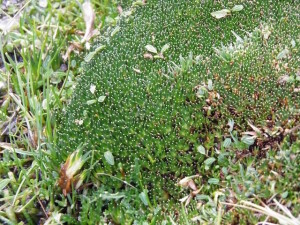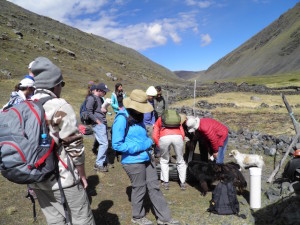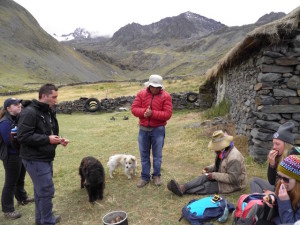We set off on our first day of field work today, with an eager and very competent group of 12 students, representing a range of disciplines within the College of Earth and Mineral Sciences. Energy engineering, energy business, geography, geoscience, and meteorology disciplines represented by students who came to this trip as open and as engaged as one could hope for. They were intent on sampling a bofedale, a unique wetland system that occurs in arid environments at high altitudes, most between 12,000 and 17,000 ft.

So even for the young and energetic, progress is slow and breathing is labored with the slightest effort. It is hard to describe how important these systems are to the people that live here: we are in the high Andes, at 15,000 ft., where precious little of the land is flat, much of the mountain is bare of vegetation because it is so arid and cold, and people depend on these oases for everything. They practice subsistence agriculture, mostly potatoes and other tubers, utilize alpaca for an amazing range of needs (fiber for clothing, meat, carrying burdens), perhaps grow a little extra potatoes to sell at market. Their name for the bofedale is simply pampa wasi, for “flat land for home”, and so their very simple homes (stone walls and a thatch roof) hug the edge of the bofedale, their alpaca graze over the bofedale for the only forage within miles, and they have some room for a garden on the edge.

You approach the site on a dirt road, the original highway that has since been replaced by the paved InterOceanic Highway (another story), bumping along around curves, slowly ascending even further. The site of the bofedale is hard to describe: it sits green and verdant at the bottom of a deep u-shaped valley, steep and bare granite sides holding it gently, with a mountain and its glacier towering over the far end. It is perhaps 5 km long, the stream from the glacier rushing down the far end, the stream channel winding its way down the long axis of the bofedale, small pools dotting a surface comprised of large pin cushions of mostly Distichia muscoides and Oxychloe andina, small, ground-hugging, amazing plants with flowers no bigger than half of the fingernail on your little finger.

I visited this site over three years ago for the first time, and when I first rounded the corner to see the mountain, the reflection off of the snow covering the peak would blind you, since it covered most of the top and the light is so clear and intense. Last year I rounded the corner and it was 30% less. This year we rounded the corner and it was gone.
Literally, gone.
I cried, and tried not to let anyone see.

The students gathered the sampling gear, and began the 20 minute, switch-backing trek down about 700 feet of elevation from the road to the bofedale surface (it will take them almost an hour to make the same trek in the opposite direction), often and gratefully using the narrow alpaca trails.

Our first stop is at the home of the president of the small community, Benito, who occupies one of five or six homes that are situated around the edge of the bofedale (one is his daughter’s, another is his son’s).

Our good friend and guide, Edwin Escalantes Mendoza, takes care of the negotiations for access, since they are often in Quechua, the language of the Incas. Luckily for us, Benito speaks in Spanish, and the first reaction is a bit confrontational. Benito has been approached before by people representing mining and oil companies, people who want his land, his only way of life, and so he is skeptical of a rather large group of foreigners, despite the youth of the student s and the innocence of their faces.

But after much explanation, opening of equipment cases holding Plexiglas tubes for core samples, showing him hollow PVC tubes that are chambers for measuring methane flux from the wetland surface, and an offering of some bread brought from the market, he not only grants us access, but invites us all to come and eat potatoes with him (the ultimate act of hospitality here).

And so we walk down the bofedale and begin our work, taking water samples for oxygen isotope analysis and basic water chemistry parameters, carbon cores, and gas samples from the methane flux chambers.

We are hoping to characterize the methane flux and carbon storage of these bofedales, and the hydrology that supports them, to ascertain their role in climate change and to predict what might happen to them, and to the local and global ecosystem services that they provide.


So after a morning of field work, we head to Benito’s simple home for a shared meal. One of the students had brought a large block of cheese for the market in Cusco, and when added to Benito’s large pot of potatoes, it seemed like a feast while sitting in the yard, Benito’s two dogs anxiously waiting for scraps of potatoes to be thrown their way.

Benito has a beautiful Andean face, high-cheekbones and skin the color of burnished bronze. His dark eyes twinkle, he wears a colorful Andean hat with pompoms hanging from the sides, with a jaunty and well-worn felt fedora atop it.

He has a worn black sweater under an equally worn brown jacket, gray wool pinstriped pants, and rubber sandals with no socks on his feet. His hair is black with no gray, and he takes great delight in Andrew’s red beard, since he has no facial hair to speak of (he asks, how can someone who is only twenty have a beard?) Benito’s small homestead consists of two simple structures, rough in construction (un-mortared field stone and thatch), with a latrine that is simply a group of rocks about 30 m from the house. He has a pen with a rabbit, about 20 guinea pigs in the house, and approximately 50 alpaca and a small herd of sheep; the sheep are a new addition, since their wool is fetching a better price at market than the alpaca. His diet consists almost entirely of alpaca and potatoes, and along with the omnipresent cultural addition of chewing coca, he is a hearty 76 year old living alone in a challenging environment. I suspect that he has never ventured more than 10 km or so from his home.

Benito said that the glacier started melting 10 years ago, and that it had greatly accelerated over the past 2 years. Now that the mountain is bare and accessible, he worries that the visits by mining and oil companies will only increase. Benito does not hold formal title to his land, his claim is one of generational presence. And so his negotiating options are limited; he could only hope for whatever money a company would offer him to move.

We finished our lunch of potatoes and cheese, gave Benito a donation of 11 soles (equal to less than $4) for access to his land, and headed up the side of the bofedale to the bus for our lunch; the effort of climbing up makes the decision to have lunch a larger one than usual. We still had work to do, and so it seemed that we had made an unfortunate logistical choice. Then the clouds form the Amazon quickly crowded out the brilliant blue sky, and a pea-sized hail and rain pelted the bus for 30 minutes or so; we were glad to have cover. It passed, the blue sky returned, and we were back down in the bofedale to finish our work. Since we are close to the equator, light and dark equally split the day, with total darkness at 5:30 pm or so. We worked quickly while the temperature started to drop quickly, and labored back up the steep hill for the second time in the waning light. Three of the students have had altitude sickness creep up on them today, and it looks as if we will be a reduced force tomorrow.


And so the 1 hour bus ride back to the lodge is quiet and in the dark; we pass women in native dress on the side of the road waiting for a ride home, motorbikes, and the large trucks that ply the InterOceanic Highway. The muted conversation consists of musings about how far from home Benito has probably been, what is his life like, and if the bofedale were to dry up, and not be able to support his alpacas and small farm, where would he go?
After Benito and the bofedale, I’m not sure that I know what I will do when I get home; I am not sure what the students will do, either. What is the teachable moment, and who is having it? I proudly work and support an institution that does research on fossil fuels, but also works hard to provide solutions to the world’s problems; that still holds significant investments in fossil fuels, but labors hard to make an education affordable and accessible; that utilizes a new high pressure natural gas line to support its steam plant, but also utilizes combined heat and power after switching from coal; that is sometimes slow to move, but holds “ensuring a sustainable future” as a foundational principle. My institution is all of those things, and if I am completely honest with myself, so am I. It may be this dualistic nature that unsettles me most, one day feeling as if the end is nigh, the next believing with all my heart in the power of knowledge to avoid catastrophe. And perhaps we, as faculty members, experience this particularly acutely. We pursued years of education because we were passionate about a field, and so we care deeply and are painfully aware when we see threats to the world we love, and yet the next moment have the privilege of seeing first hand the power of youth and a new approach. The challenge is not to turn our faces, to avoid the pain and the challenge of resolving it. And so I find myself trying to download the book Active Hope by Joanna Macy and Chris Johnstone, on an incredibly slow internet in the high Andes, desperate for guidance. They argue that having gratitude is the first step to healing that pain, that we then become more present to the wonder of being alive in this amazing world. Yet the very act of looking at what we love and value in our world brings with it an awareness of the vast violation under way. “By honouring our pain for the world, we break through the taboos that silence our distress. When the activating siren of inner alarm is no longer muffled or shut out, something gets switched on inside us. It is our survival response.”
And so perhaps I will huddle under my mountain of blankets in my room tonight (there is no central heating), reading Active Hope on an ipad under the covers. And I will be grateful that I am so privileged to have the knowledge of both the beauty of the world, and the knowledge of what is happening to it. And I will be even more grateful that I have the honor of teaching and watching my students. They are the source of the strength to lean in, to let the alarm sound. And I will see what I do with that when I get home.

Thank you!